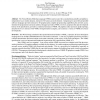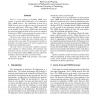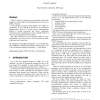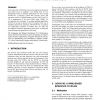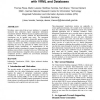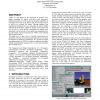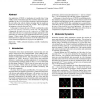CACM
1998
14 years 2 months ago
1998
Abstract. The Virtual Reality Modeling Language (VRML) and Java provide a standardized, portable and platformindependent way to render dynamic, interactive 3D scenes across the Int...
COMPSAC
2001
IEEE
14 years 6 months ago
2001
IEEE
Virtual Reality Modeling Language (VRML) is widely used to represent, create, and display virtual reality objects and their environment. Some VRML applications require concurrent ...
CGI
2001
IEEE
14 years 6 months ago
2001
IEEE
Javra is a Java package for handling VRML scene graphs; it operates either stand-alone or in combination with a VRML browser. The combination of Javra and a VRML browser forms an ...
VRML
1998
ACM
14 years 6 months ago
1998
ACM
VRML 2.0 allows a content creator to dynamically control state changes in a virtual reality world by defining routes of events over VRML 2.0 nodes. In the conceptual execution mod...
VRML
1998
ACM
14 years 6 months ago
1998
ACM
In its current state, VRML does not provide support for interaction and on-line access to databases, even though these are two fundamental issues for business applications. We hav...
VRML
1998
ACM
14 years 6 months ago
1998
ACM
VRML offers a high potential for product presentation: Instead of regarding flat, static pictures, configurable and animated 3D models embedded in entertaining environments provid...
NPIV
1998
ACM
14 years 6 months ago
1998
ACM
Nowadays, many state-of-the-art user interfaces to complexly structured data collections require appropriate information visualization methods. With the increase in graphics perfo...
CGI
1998
IEEE
14 years 6 months ago
1998
IEEE
This article discusses visualizing and interacting with 3-D geographical data via VRML in the Web environment. For this purpose, the Web-based desktop VR for geographical informat...
VRML
1999
ACM
14 years 6 months ago
1999
ACM
VRML is a file format for the description of dynamic scene graphs containing 3D objects with their visual appearance, multimedia content, an event model, and scripting capabilitie...
VRML
1999
ACM
14 years 6 months ago
1999
ACM
One application of VRML is visualisation of scientific data. Using VRML results of simulations and other scientific endeavours can be published on the web with all the advantage...
